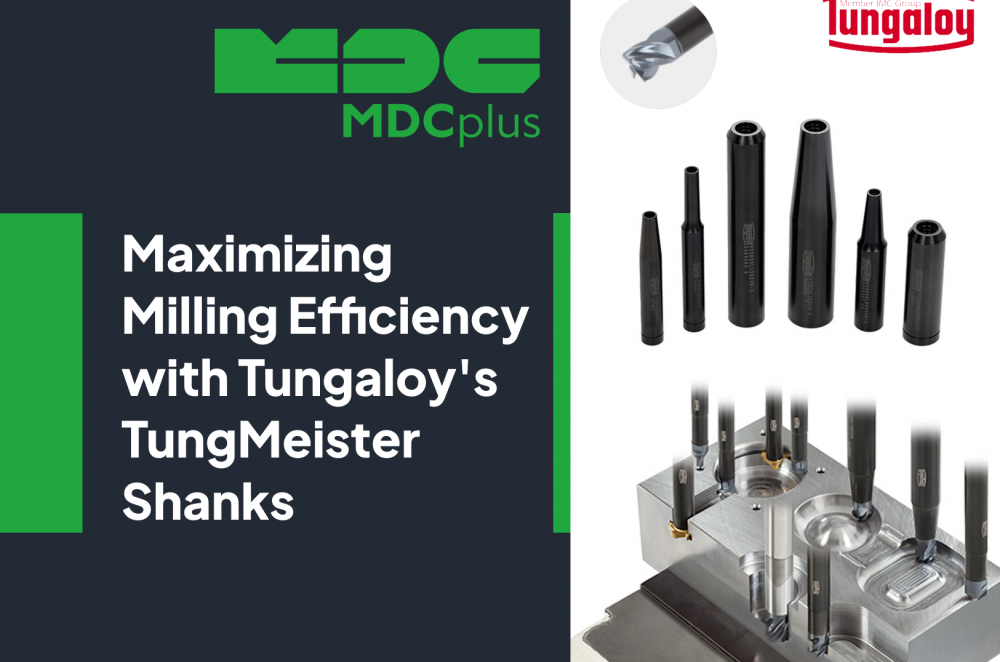Maximizing Milling Efficiency with Tungaloy's TungMeister Shanks
These upgrades directly target core issues in high-mix, high-precision production — namely vibration, accessibility, and changeover time — making them especially impactful for manufacturers operating under high volume and tight tolerances.
Structural Upgrades that Drive Results
High-Rigidity Shanks: Reinforced for Demanding Cuts
The new VSSD-style shanks feature significantly increased core diameters, delivering a 200–320% boost in flexural rigidity. This added stiffness enables deeper axial and radial cuts while suppressing vibration and chatter — a key limitation in traditional long-overhang tools.
Performance tests on stainless steel have shown up to 2.7× longer tool life, directly attributed to improved chip control, reduced edge chipping, and enhanced heat stability during heavy cutting.
Tapered-Neck Shanks: Clearance without Compromise
The tapered-neck design allows machining in tight or deep geometries while maintaining structural strength. This helps prevent collision with part walls or fixtures, expanding the tool’s reach into constrained zones without resorting to weaker, extended-length tools.
Modular System Efficiency
TungMeister’s exchangeable-head system brings significant operational advantages:
-
Under 1-minute head changes — compared to 10+ minutes with solid carbide tools
-
No need to remove the shank from the spindle, reducing setup time and preserving machine alignment
-
Repeatable precision with runout and height tolerances held within ~20 µm
This modularity is particularly effective in high-mix or automated environments, where tool changeover time directly impacts spindle uptime.
Enhanced Productivity Metrics
These mechanical and operational upgrades translate to:
-
Up to 2.5× higher metal removal rates
-
More consistent process stability due to reduced tool vibration
-
Significantly longer tool life, especially in difficult-to-machine materials
Coating technologies such as AH715 and AH735 further extend life and performance under high-load conditions.
Machine Compatibility: Open, Not Exclusive
TungMeister is not tied to any specific machine tool brand. It’s compatible with a wide range of modern machining centers, including vertical, horizontal, and multi-tasking platforms — provided they accept standard ER collet, shrink-fit, or hydraulic holders.
Ideal Machine Types:
-
High-speed vertical and horizontal machining centers
-
Mill-turn centers with live tooling
-
Automation-ready cells where uptime and quick-change capability are critical
Tapered and rigid shanks work best with machines offering solid spindle support and stable toolholding — but they do not require any proprietary software or control systems.
Final Perspective
Tungaloy’s TungMeister expansion addresses three key demands in modern machining: stability, accessibility, and efficiency. With better rigidity for aggressive cutting, tapered geometries for difficult features, and modular heads that minimize downtime, it’s a tooling platform designed for manufacturers who treat time and consistency as strategic levers.
Whether you're machining in a high-speed cell or running complex prototypes, these upgrades provide measurable improvements in tool life, cut quality, and operational flexibility — all without tying you to any single machine architecture.
About MDCplus
Our key features are real-time machine monitoring for swift issue resolution, power consumption tracking to promote sustainability, computerized maintenance management to reduce downtime, and vibration diagnostics for predictive maintenance. MDCplus's solutions are tailored for diverse industries, including aerospace, automotive, precision machining, and heavy industry. By delivering actionable insights and fostering seamless integration, we empower manufacturers to boost Overall Equipment Effectiveness (OEE), reduce operational costs, and achieve sustainable growth along with future planning.
Ready to increase your OEE, get clearer vision of your shop floor, and predict sustainably?
